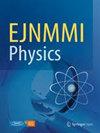90Y SPECT scatter estimation and voxel dosimetry in radioembolization using a unified deep learning framework
IF 3
2区 医学
Q2 RADIOLOGY, NUCLEAR MEDICINE & MEDICAL IMAGING
引用次数: 0
Abstract
90Y SPECT-based dosimetry following radioembolization (RE) in liver malignancies is challenging due to the inherent scatter and the poor spatial resolution of bremsstrahlung SPECT. This study explores a deep-learning-based absorbed dose-rate estimation method for 90Y that mitigates the impact of poor SPECT image quality on dosimetry and the accuracy–efficiency trade-off of Monte Carlo (MC)-based scatter estimation and voxel dosimetry methods. Our unified framework consists of three stages: convolutional neural network (CNN)-based bremsstrahlung scatter estimation, SPECT reconstruction with scatter correction (SC) and absorbed dose-rate map generation with a residual learning network (DblurDoseNet). The input to the framework is the measured SPECT projections and CT, and the output is the absorbed dose-rate map. For training and testing under realistic conditions, we generated a series of virtual patient phantom activity/density maps from post-therapy images of patients treated with 90Y-RE at our clinic. To train the scatter estimation network, we use the scatter projections for phantoms generated from MC simulation as the ground truth (GT). To train the dosimetry network, we use MC dose-rate maps generated directly from the activity/density maps of phantoms as the GT (Phantom + MC Dose). We compared performance of our framework (SPECT w/CNN SC + DblurDoseNet) and MC dosimetry (SPECT w/CNN SC + MC Dose) using normalized root mean square error (NRMSE) and normalized mean absolute error (NMAE) relative to GT. When testing on virtual patient phantoms, our CNN predicted scatter projections had NRMSE of 4.0% ± 0.7% on average. For the SPECT reconstruction with CNN SC, we observed a significant improvement on NRMSE (9.2% ± 1.7%), compared to reconstructions with no SC (149.5% ± 31.2%). In terms of virtual patient dose-rate estimation, SPECT w/CNN SC + DblurDoseNet had a NMAE of 8.6% ± 5.7% and 5.4% ± 4.8% in lesions and healthy livers, respectively; compared to 24.0% ± 6.1% and 17.7% ± 2.1% for SPECT w/CNN SC + MC Dose. In patient dose-rate maps, though no GT was available, we observed sharper lesion boundaries and increased lesion-to-background ratios with our framework. For a typical patient data set, the trained networks took ~ 1 s to generate the scatter estimate and ~ 20 s to generate the dose-rate map (matrix size: 512 × 512 × 194) on a single GPU (NVIDIA V100). Our deep learning framework, trained using true activity/density maps, has the potential to outperform non-learning voxel dosimetry methods such as MC that are dependent on SPECT image quality. Across comprehensive testing and evaluations on multiple targeted lesions and healthy livers in virtual patients, our proposed deep learning framework demonstrated higher (66% on average in terms of NMAE) estimation accuracy than the current “gold-standard” MC method. The enhanced computing speed with our framework without sacrificing accuracy is highly relevant for clinical dosimetry following 90Y-RE.使用统一的深度学习框架在放射性栓塞中进行 90Y SPECT 散射估计和体素剂量测定
由于轫致辐射SPECT固有的散射和较差的空间分辨率,肝脏恶性肿瘤放射栓塞术(RE)后基于90Y SPECT的剂量测定具有挑战性。本研究探索了一种基于深度学习的 90Y 吸收剂量率估算方法,该方法可减轻 SPECT 图像质量差对剂量测定的影响,以及基于蒙特卡罗(MC)的散射估算和体素剂量测定方法的准确性-效率权衡。我们的统一框架由三个阶段组成:基于卷积神经网络(CNN)的轫致辐射散射估计、SPECT 重建与散射校正(SC)以及利用残差学习网络(DblurDoseNet)生成吸收剂量率图。该框架的输入是测量的 SPECT 投影和 CT,输出是吸收剂量率图。为了在真实条件下进行训练和测试,我们从本诊所接受 90Y-RE 治疗的患者的治疗后图像中生成了一系列虚拟患者模型活动/密度图。为了训练散射估计网络,我们使用 MC 模拟生成的幻影散射投影作为地面实况(GT)。为了训练剂量测定网络,我们使用直接从模型的活动/密度图生成的 MC 剂量率图作为 GT(模型 + MC 剂量)。我们使用归一化均方根误差(NRMSE)和归一化平均绝对误差(NMAE)比较了我们的框架(SPECT w/CNN SC + DblurDoseNet)和 MC 剂量测定(SPECT w/CNN SC + MC Dose)相对于 GT 的性能。在虚拟病人模型上进行测试时,我们的 CNN 预测散射投影的 NRMSE 平均为 4.0% ± 0.7%。在使用 CNN SC 的 SPECT 重建中,我们观察到 NRMSE(9.2% ± 1.7%)比不使用 SC 的重建(149.5% ± 31.2%)有显著改善。在虚拟患者剂量率估计方面,SPECT w/CNN SC + DblurDoseNet 在病变肝脏和健康肝脏中的 NMAE 分别为 8.6% ± 5.7% 和 5.4% ± 4.8%;而 SPECT w/CNN SC + MC Dose 的 NMAE 分别为 24.0% ± 6.1% 和 17.7% ± 2.1%。在患者剂量率图中,虽然没有GT,但我们观察到病变边界更清晰,病变与背景的比率在我们的框架下也有所提高。对于一个典型的患者数据集,在单个 GPU(英伟达 V100)上,经过训练的网络生成散点估计需要约 1 秒,生成剂量率图需要约 20 秒(矩阵大小:512 × 512 × 194)。我们的深度学习框架使用真实的活动/密度图进行训练,有望超越依赖于 SPECT 图像质量的非学习体素剂量测定方法(如 MC)。通过对虚拟患者的多个靶向病灶和健康肝脏进行全面测试和评估,我们提出的深度学习框架显示出比当前 "黄金标准 "MC 方法更高的估算准确率(NMAE 平均为 66%)。我们的框架在不牺牲准确性的情况下提高了计算速度,这与 90Y-RE 后的临床剂量测定高度相关。
本文章由计算机程序翻译,如有差异,请以英文原文为准。
求助全文
约1分钟内获得全文
求助全文
来源期刊

EJNMMI Physics
Physics and Astronomy-Radiation
CiteScore
6.70
自引率
10.00%
发文量
78
审稿时长
13 weeks
期刊介绍:
EJNMMI Physics is an international platform for scientists, users and adopters of nuclear medicine with a particular interest in physics matters. As a companion journal to the European Journal of Nuclear Medicine and Molecular Imaging, this journal has a multi-disciplinary approach and welcomes original materials and studies with a focus on applied physics and mathematics as well as imaging systems engineering and prototyping in nuclear medicine. This includes physics-driven approaches or algorithms supported by physics that foster early clinical adoption of nuclear medicine imaging and therapy.
 求助内容:
求助内容: 应助结果提醒方式:
应助结果提醒方式:


